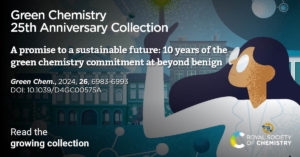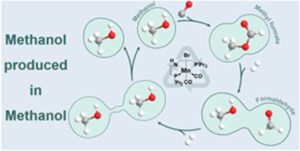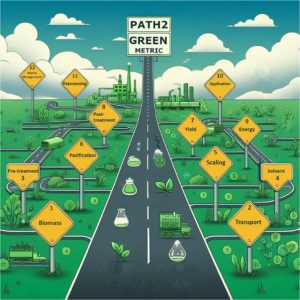
Over the past 25 years, Green Chemistry has provided a unique forum for the publication of innovative research on the development of alternative sustainable technologies, efficient utilisation of resources and the concomitant minimisation of waste. We are delighted to bring together a very special collection containing articles by members of the green chemistry community as well as past and present Green Chemistry Board members, to mark and celebrate our first 25 years.
Among the contributions to this themed collection is a Perspective on the 10 years of the Green Chemistry Commitment at Beyond Benign (DOI: 10.1039/D4GC00575A).
Read our interview with Amy Cannon and Juliana Vidal, two of the authors
 Could you briefly explain the focus of your article to the non-specialist?
Could you briefly explain the focus of your article to the non-specialist?
Beyond Benign is a non-profit organization passionate and dedicated to empowering the entire chemistry community to achieve a sustainable future through education. To catalyze the reach and depth of this support in higher education, Beyond Benign created and launched the Green Chemistry Commitment (GCC) program in 2013, a voluntary and non-prescriptive promise from colleges, universities, and institutes worldwide to incorporate green chemistry into their curriculum.
How would you set this article in a wider context?
Education in green chemistry is the fundamental piece to the achievement of a sustainable future since it can give current and future scientists the skills to design products and processes with human health and the environment in mind. Through the GCC program, entire higher education institutions have become part of a collective voice that believes in and works together towards a better planet for this and the generations to come. The green chemistry adoption approaches pursued by more than 150 institutions participating in the GCC reflect the diversity of cultures, resources, locations, and individuals within the community and their impact on over 3,300 faculty members and 840,000 students annually. Since publication, this community has grown to over 215 institutions and 5,000 faculty members reaching over 1.2 million students annually.
What is the motivation behind this work?
Together, we are stronger. Regardless of the approach taken or resources used, the green chemistry community is created and maintained by inspiring individuals who are constantly defying the status quo to achieve systemic change locally and globally. This article is a celebration of all the collective efforts taken to promote this meaningful and impactful change, as well as a recognition of the remarkable work performed in the last 10 years by the institutions participating in the GCC community.
What aspects of this work are you most excited about at the moment and what do you find most challenging about it?
It is very exciting to see the increasing number of colleges, institutes, and universities joining the GCC program, as well as their unique institutional journeys to green chemistry integration, adoption, and dissemination. It is also encouraging to see the green chemistry path of our community members and watch some of them become leaders in the field, acting as ‘agents of change’ to further inspire the adoption of sustainable practices regardless of their environments, locations, and roles. Although several milestones have been achieved in these 10 years of the GCC program, the most challenging aspect is and will always be the resistance to change. Adding ‘something new’ to an already jam-packed curriculum can bring a certain level of discomfort and a sense of control loss to some institutions and individuals regarding the inclusion of green chemistry topics in undergraduate and graduate courses. However, teaching and practicing the traditional chemistry concepts ‘through the lens of green chemistry’ can go a long way and promote impactful incremental changes that could inspire a whole generation of future scientists to think about human health and the environment during their molecular design.
What is the next step? What work is planned?
The ultimate goal of the GCC program is to host a community of transformation around green chemistry, where the individuals in the participant institutions can promote a revolutionary education reform through the living and interdisciplinary integration of green chemistry and sustainability. To do so, the next step of the GCC is to enhance the support of its current signers through grants, professional development, mentoring, and leadership opportunities, as well as increasing the number of institutions in the program. Through an empowered community of transformation, green chemistry can finally achieve its goal of becoming ‘just chemistry’ and the inherent way molecular designers create benign building blocks for products used by our society every day.
Please describe your journey to becoming part of the Green Chemistry community.
Amy Cannon: I was very passionate about sustainability at an early age, but didn’t know how to apply that passion. I studied chemistry in undergrad and was going to use my chemistry skills to study environmental problems. I applied to graduate programs and was admitted to a multi-disciplinary program at the University of Massachusetts in Boston that was focused on environmental sciences. I was assigned an advisor from the chemistry department due to my chemistry background. That advisor was Dr John Warner. Once I learned about green chemistry from him, I quickly turned back to a chemistry major and helped to create the world’s first Ph.D. program in green chemistry. I was the first graduate from that program in 2005.
Juliana Vidal: I discovered green chemistry in the very last year of my B.Sc. studies. I was reading an environmental chemistry book and studying for my exam when I saw a page with a picture of John Warner and Paul Anastas. I simply fell in love with the field and started to wonder why I had not learned about it before, which was the main motivation for my green chemistry journey and my work as a Program Manager at Beyond Benign. For those reasons, I was thrilled that my debut as part of the Green Chemistry journal community was in a work that discusses, promotes, and celebrates these collective journeys through the GCC program, and it is the result of a collaborative effort with some of my personal heroes, such as Amy Cannon, Natalie O’Neil, and John Warner.
Why did you choose to publish in Green Chemistry?
Besides its reputation for being one of the most influential and important journals in the field, Green Chemistry has recently released a ‘Green Chemistry 25th Anniversary Collection’ Special Issue. As our team at Beyond Benign also looks to celebrate the work performed by our GCC participant institutions throughout the 10 years of the program, the Green Chemistry journal could not be a better place for this work to live and this double celebration to happen.
What do you think the Green Chemistry journal has done well in the past 25 years, and what do you think are the main challenges our community will face in the next 25 years?
Throughout 25 years, the Green Chemistry journal has been home to some of the most important discoveries in the field, highlighting diverse approaches to green chemistry innovation and, most importantly, adapting itself to the new and incoming trends in green chemistry teaching and research. However, as new methods, processes, strategies, and even definitions emerge, our community will need to be as collaborative and as adaptable as possible to promote an in-depth inclusion of the field across sectors, organizations, and institutions within our society. However, acknowledging the past, recognizing mistakes, and planning a better future is something our community has excelled at throughout these 25 years, and that can still be our strength for the next 25 years to come.
Meet the authors
 |
Dr Amy Cannon (she/her) is the Co-Founder and Executive Director of Beyond Benign, an organization that develops and disseminates green chemistry educational resources that empower educators, students and the community at large to practice sustainability through chemistry. She holds the world’s first Ph.D. in Green Chemistry from the University of Massachusetts Boston, and she worked as an Assistant Professor of Green Chemistry and Director of Outreach and Community Education at the Center for Green Chemistry at the University of Massachusetts Lowell. Amy was awarded the Kenneth G. Hancock Memorial Award in Green Chemistry in 2004 and the 2012 EPA New England Environmental Merit award for her leadership and work on green chemistry education, where she is focused on better-preparing students and scientists to enter the workforce trained with the skills to create sustainable materials and products. Through Beyond Benign, Amy leads many educational initiatives to bring together multiple stakeholders around this common goal. |
 |
Dr Juliana Vidal(she/her) is a Senior Program Manager at Beyond Benign, where she is dedicated to supporting the incorporation of green chemistry in higher education through the Green Chemistry Commitment (GCC) program. She completed her Ph.D. at Memorial University of Newfoundland, investigating new applications for a sustainable material obtained from wood waste. As a Postdoctoral Researcher at McGill University, she helped to develop greener methods for the implementation of a marine biorefinery. Juliana is the Co-Chair of the Global Conversation on Sustainability (GCS) project, a National Representative of the IUPAC’s Committee on Chemical Research Applied to World Needs (CHEMRAWN), a Coordination Member of the Chemicals & Waste Platform of the United Nations Environment Programme Major Group for Children and Youth, and was selected in 2020 a Chemical Abstracts Service (CAS) Future Leader. |
 Green Chemistry, Journal of Material Chemistry A, Sustainable Energy & Fuels and RSC Sustainability are delighted to announce that our latest cross journal themed collection on Green and Sustainable Batteries is now online and free to access until the end of January, 2026.
Green Chemistry, Journal of Material Chemistry A, Sustainable Energy & Fuels and RSC Sustainability are delighted to announce that our latest cross journal themed collection on Green and Sustainable Batteries is now online and free to access until the end of January, 2026.





































